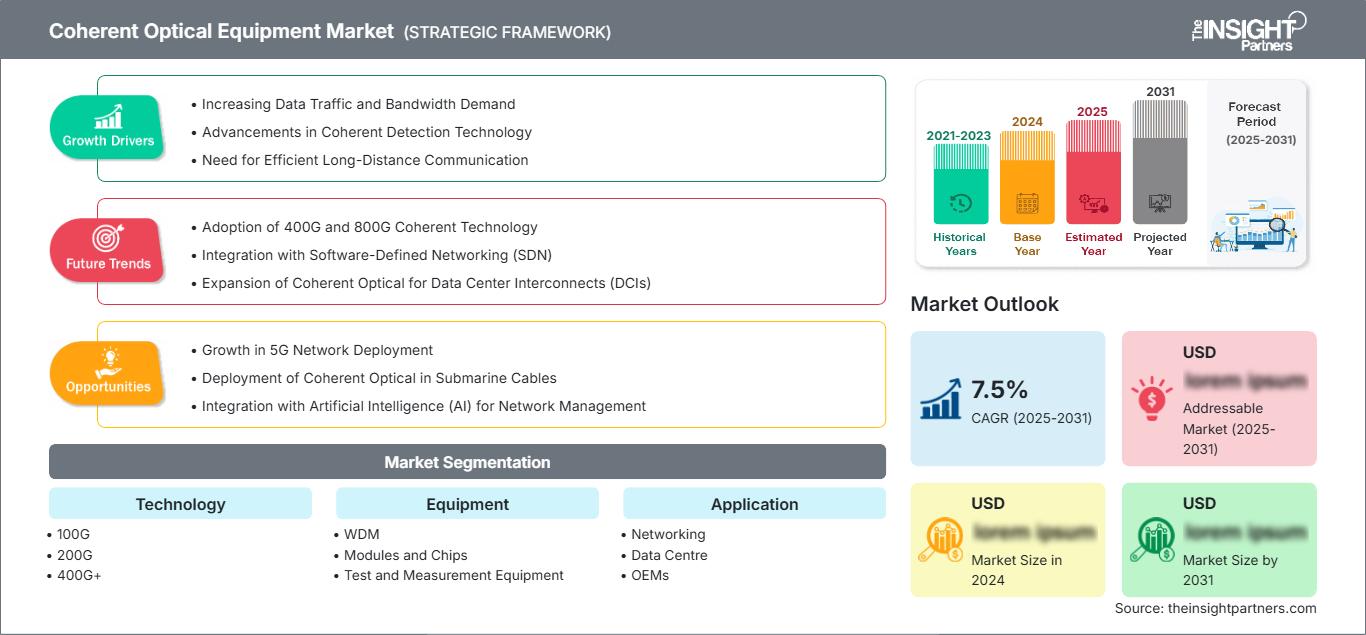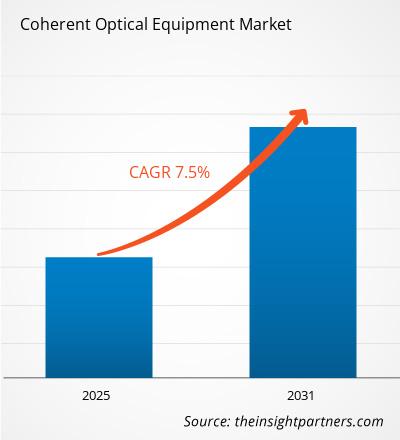页面已更新 :
Jan 2025
预计相干光学设备市场在 2025 年至 2031 年期间的复合年增长率为 7.5%,市场规模将从 2024 年的 XX 百万美元扩大到 2031 年的 XX 百万美元。
该报告按技术(100G、200G、400G+、400G ZR)细分;设备(WDM、模块和芯片、测试和测量设备、光开关、光放大器等);应用(网络、数据中心、OEM);行业垂直领域(互联网服务提供商、电信服务提供商、航空、能源、铁路等)。全球分析进一步细分为区域和主要国家。该报告以美元提供了上述分析和细分的价值。
报告目的
Insight Partners 发布的《相干光学设备市场》报告旨在描述当前形势和未来增长、主要驱动因素、挑战和机遇。这将为各种商业利益相关者提供见解,例如:
- 技术提供商/制造商:了解不断变化的市场动态并了解潜在的增长机会,使他们能够做出明智的战略决策。
- 投资者:对市场增长率、市场财务预测和整个价值链中存在的机会进行全面的趋势分析。
- 监管机构:规范市场政策和警察活动,旨在最大限度地减少滥用,维护投资者的信任和信心,维护市场的完整性和稳定性。
相干光设备市场细分技术
- 100G
- 200G
- 400G+
- 400G ZR
设备
- WDM
- 模块和芯片
- 测试和测量设备
- 光开关
- 光放大器
- 其他
应用
- 网络
- 数据中心
- 原始设备制造商
垂直行业
- 互联网服务提供商
- 电信服务提供商
- 航空
- 能源
- 铁路
- 其他
自定义此报告以满足您的要求
您将免费获得任何报告的定制,包括本报告的部分内容,或国家级分析、Excel 数据包,以及为初创企业和大学提供超值优惠和折扣
相干光设备市场: 战略洞察

- 获取本报告的主要市场趋势。这个免费样本将包括数据分析,从市场趋势到估计和预测。
相干光设备市场增长动力
- 不断增长的数据流量和带宽需求:受云计算、物联网和 5G 网络等趋势推动,数据流量快速增长,对更高带宽和更快数据传输的需求也随之增加。相干光技术可实现远超传统光系统的传输速度,对于满足电信和数据中心日益增长的数据容量需求至关重要。
- 相干检测技术的进步:相干检测技术的重大技术进步彻底改变了光通信。这些发展使得长距离数据传输更加高效、可靠,且不会出现信号衰减,从而提升了光网络的性能。相干光设备增强的检测能力支持更高的调制格式和先进的纠错技术,推动了其在现代通信系统中的广泛应用。
- 高效长距离通信的需求:相干光设备是提高长距离通信网络效率的关键。由于数据中心、电信提供商和企业需要可靠且高容量的网络来连接全球各个区域,采用先进调制方案和信号处理技术的相干光系统有助于减少传统上与长距离光纤网络相关的信号丢失和延迟。
相干光设备市场未来趋势
- 400G 和 800G 相干技术的采用:随着网络运营商努力满足日益增长的高速互联网和可靠数据传输需求,400G 和 800G 相干光技术的采用正在迅速增加。电信网络骨干基础设施和云数据中心对更高带宽的需求推动了这一趋势,从而导致了能够支持这些更高传输速度的设备的发展。
- 与软件定义网络 (SDN) 集成:相干光设备与软件定义网络 (SDN) 的集成是一种日益增长的趋势。 SDN 能够更灵活、更可扩展、更高效地管理网络资源,使运营商能够动态调整流量路由。相干光系统正被纳入 SDN 框架,以增强网络容量、提升网络优化水平并确保资源高效利用,从而推动其应用范围的扩大。
- 数据中心互连 (DCI) 相干光技术的扩展:随着数据中心互连需求的增长,相干光技术正越来越多地应用于这些连接。数据中心之间对高性能、低延迟互连的需求推动了 DCI 采用相干光技术的趋势,这使得企业能够高效处理海量数据,这对于支持不断增长的云和大数据服务市场至关重要。
相干光设备市场机遇
- 5G 网络部署的增长:5G 网络的持续部署为相干光设备市场带来了巨大的机遇。由于 5G 基础设施需要超低延迟和高速数据传输,预计对能够满足这些要求的先进光学解决方案的需求将会增长。相干光学设备可以满足这些要求,使其成为 5G 网络骨干网的重要组成部分。
- 海底电缆中相干光学的部署:相干光学技术在构成国际互联网连接骨干网的海底电缆系统中的应用日益广泛。这些电缆需要支持高容量和长距离通信,且不能丢失信号。随着全球互联网基础设施的扩张和对更高数据传输需求的增长,在海底电缆中部署相干光学系统带来了一个充满希望的增长机会。
- 与人工智能 (AI) 集成进行网络管理:人工智能 (AI) 与相干光学设备的集成为市场带来了巨大的机遇。AI 可以通过实时监控和调整流量来优化网络性能,减少拥塞并提高可靠性。人工智能与相干光系统的结合,可以实现更加智能、自优化的光网络,从而显著提高效率并降低运营成本。
相干光学设备市场区域洞察
The Insight Partners 的分析师已详尽阐述了预测期内影响相干光学设备市场的区域趋势和因素。本节还讨论了北美、欧洲、亚太地区、中东和非洲以及南美和中美洲的相干光学设备市场细分和地域分布。
相干光学设备市场报告范围
| 报告属性 | 细节 |
|---|---|
| 市场规模 2024 | US$ XX million |
| 市场规模 2031 | US$ XX Million |
| 全球复合年增长率 (2025 - 2031) | 7.5% |
| 历史数据 | 2021-2023 |
| 预测期 | 2025-2031 |
| 涵盖的领域 |
By 技术
|
| 覆盖地区和国家 | 北美
|
| 市场领导者和主要公司简介 |
|
相干光学设备市场参与者密度:了解其对业务动态的影响
相干光学设备市场正在快速增长,这得益于终端用户需求的不断增长,而这些需求的驱动因素包括消费者偏好的不断变化、技术进步以及对产品优势的认知度不断提高。随着需求的增长,企业正在扩展产品线,不断创新以满足消费者需求,并抓住新兴趋势,从而进一步推动市场增长。

- 获取 相干光设备市场 主要参与者概述
主要卖点
- 全面覆盖:本报告全面涵盖了相干光学设备市场的产品、服务、类型和最终用户的分析,提供了整体格局。
- 专家分析:本报告基于对行业专家和分析师的深入了解而编写。
- 最新信息:由于涵盖了最新信息和数据趋势,本报告确保了业务相关性。
- 定制选项:本报告可以根据特定客户要求进行定制,并恰如其分地适应业务战略。
因此,相干光学设备市场研究报告可以帮助引领解读和理解行业情景和增长前景的线索。尽管可能存在一些合理的担忧,但本报告的总体优势往往大于劣势。
- 历史分析(2 年)、基准年、预测(7 年)及复合年增长率
- PEST和SWOT分析
- 市场规模、价值/数量 - 全球、区域、国家
- 行业和竞争格局
- Excel 数据集
近期报告
客户评价
购买理由
- 明智的决策
- 了解市场动态
- 竞争分析
- 客户洞察
- 市场预测
- 风险规避
- 战略规划
- 投资论证
- 识别新兴市场
- 优化营销策略
- 提升运营效率
- 顺应监管趋势
我们的客户































87-673-9708

ISO 9001:2015



 获取免费样品 - 相干光设备市场
获取免费样品 - 相干光设备市场